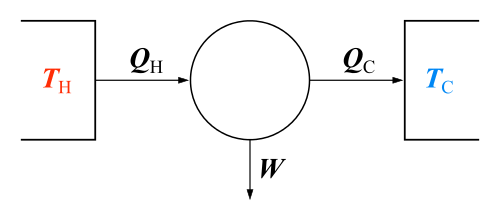Vuilleumier cycle
| Thermodynamics | ||||||||||||
|---|---|---|---|---|---|---|---|---|---|---|---|---|
 The classical Carnot heat engine | ||||||||||||
|
||||||||||||
| Book:Thermodynamics | ||||||||||||
The Vuilleumier cycle is a thermodynamic cycle with applications in low-temperature cooling. In some respects it resembles a Stirling cycle or engine, although it has two "displacers" with a mechanical linkage connecting them as compared to one in the Stirling cycle. The hot displacer is larger than the cold displacer. The coupling maintains the appropriate phase difference. The displacers do no work—they are not pistons. Thus no work is required in an ideal case to operate the cycle. In reality friction and other losses mean that some work is required.
Devices operating on this cycle have been able to produce temperatures as low as 15 K using liquid nitrogen to pre-cool. Without precooling 77 K was reached with a heat flow of 1 W.
The cycle was first patented by Vuilleumier in 1918 with patent US1275507, and again in Leiden by KW Taconis in 1951. In March 2014, the Vuilleumier Cycle was tested in application with updating conventional HVAC (heating, ventilation, and air-conditioning) systems by utilizing the cycle's proposed thermodynamic process of moving heat energy, and having results of increased output efficiencies coupled with a reduced carbon footprint.[1] This work was completed by ThermoLift (http://www.tm-lift.com/), a company based out of the Advanced Energy Research and Technology Center at Stony Brook University, with collaboration from the US Department of Energy and the New York State Energy Research and Development Authority (NYSERDA).[2]
External links
| Wikimedia Commons has media related to Vuilleumier cycle. |
References
- Experimental techniques in low-temperature physics, Guy Kendall White, Philip J. Meeson, Oxford University Press, 2002, p. 30 Link
- Energy Savings Potential and RD&D Opportunities for Non-Vapor-Compression HVAC Technologies, U.S. Department of Energy, William Goetzler, Robert Zogg, Jim Young, Caitlin Johnson, Navigant Consulting, Inc. March 2014 Link